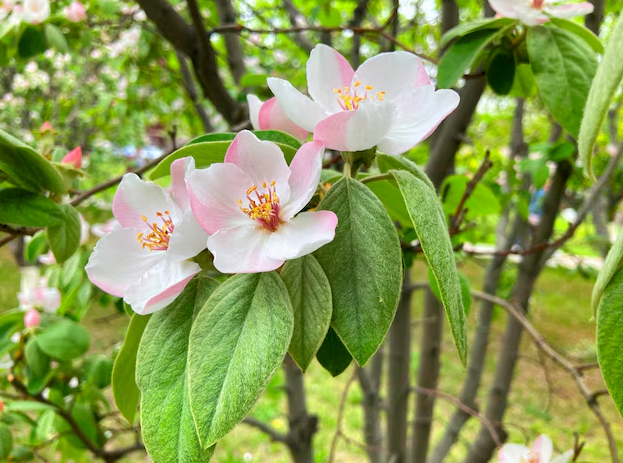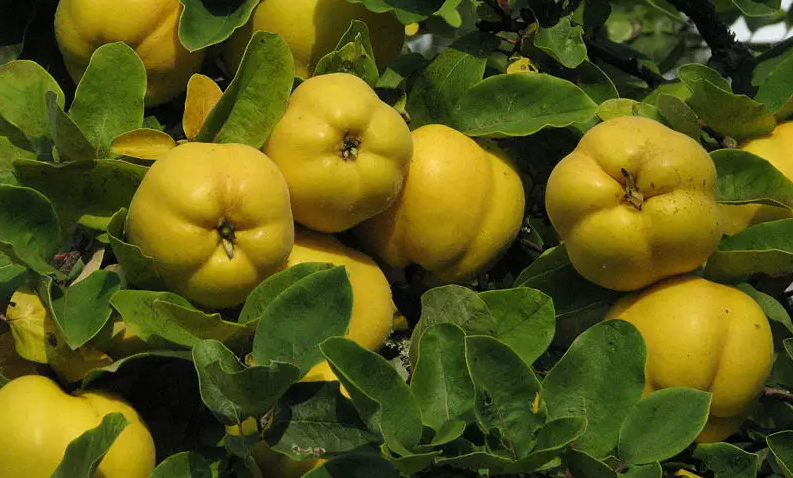
Quinces are botanically classified as Cydonia oblonga and belong to the Rose family. Quinces are closely related to pears and apples, which is evident from their similar appearance. The quince is the sole member of the genus Cydonia in the Malinae subtribe of the Rosaceae family.
Quinces are native to Western Asia and the Caucasus region of Southeastern Europe, with their origins believed to be in Iran and Turkestan. They were traded and cultivated throughout the Middle East and the Mediterranean for centuries and were once grown on trees throughout the city of Cydonia in Crete, which is modern-day Khania.
Quince trees are generally smaller than apple or pear trees, typically reaching heights of 15 to 20 feet (4.5 to 6 meters) with a similar spread. They have a somewhat irregular, spreading growth habit. The leaves are simple, alternate, and broadly oval, with a serrated margin. They turn golden in the fall. Trees bloom in late spring with pink or white flowers that are quite showy.

Quince fruits are golden-yellow when ripe, with a pear-like shape but more angular and sometimes a bit larger. They have a fuzzy, golden skin. Raw quince is hard, astringent, and sour, making it inedible when uncooked. However, once cooked, it transforms into a sweet, aromatic fruit with a texture similar to apple sauce or a firm apple. They come in many varieties, including Smyrna, Angers, Champion, Pineapple, and Orange Quinces. Quince has a distinctive, fragrant aroma, often described as a mix of apple, pear, and a hint of floral notes. This scent becomes more pronounced when the fruit is cooked.
Quince is usually poached, baked, or made into jams, jellies, and marmalades. It’s famous for its high pectin content, which makes it excellent for jams. In many cultures, quince features in traditional recipes. For example, in Middle Eastern cuisine, it might be used in stews or as a sweet accompaniment to meat dishes. In Europe, it’s often seen in desserts or as a preserve.
Quince is rich in vitamin C, dietary fiber, and contains some potassium, iron, and vitamin B. It contains antioxidants like polyphenols, which can help combat oxidative stress. To store Quinces longer, wrap each fruit individually in a double layer of plastic and refrigerate.
Quince is cultivated on all continents in warm-temperate and temperate climates. They continue to be widely farmed in Chile, Argentina, South Africa, Australia, Europe, Morocco, Iran, and Turkey. Outside of these areas, Quince trees may be planted from seed in gardens and orchards or the fruit may be found at farmers’ markets and grocery stores that specialize in international produce. They are eaten raw or processed into marmalade, jam, paste (known as quince cheese) or alcoholic beverages. In 2021, world production of quinces was 697,563 tonnes, with Turkey and China accounting for 43% of the world total (table).
Quince requires a cooler period of the year, with temperatures under 7 °C (45 °F), to flower properly. Propagation is done by cuttings or layering; the former method produces better plants, but they take longer to mature than by the latter. Named cultivars are propagated by cuttings or layers grafted on quince rootstock. Propagation by seed is not used commercially. Quince forms thick bushes, which must be pruned and reduced into a single stem to grow fruit-bearing trees for commercial use. The tree is self-pollinated, but it produces better yields when cross-pollinated.
Cultivation
Growing Conditions:
- Climate: Quince trees thrive in temperate climates. They are hardy but prefer regions with cold winters and warm summers. However, they are less tolerant of extreme cold compared to some other fruit trees.
- Soil: They do best in well-drained, fertile soil with a slightly acidic to neutral pH. Quince trees are somewhat more tolerant of poor soil conditions than many fruit trees but still perform better with good soil management.
- Sunlight: Full sun is ideal for quince trees. They require at least 6 hours of direct sunlight daily for optimal growth and fruit production.
- Watering: While established trees are somewhat drought-resistant, consistent moisture, especially during fruit development, helps in producing better quality fruit.
Cultivation:
- Planting: Quince trees are often grafted onto rootstocks for better disease resistance and vigor. Planting should be done in early spring or late fall.
- Pruning: Pruning is necessary to maintain shape, remove dead wood, and improve air circulation. Quince trees can be pruned in late winter or early spring before new growth begins.
- Pests and Diseases: Quince trees can be susceptible to fire blight, a bacterial disease, and various fungal issues like leaf spot or rust. Regular monitoring and proper cultural practices can help manage these issues.
Harvesting:
- Timing: Quince fruits are typically ready for harvest in late autumn. They should be picked when fully colored but still firm, as they ripen further off the tree.
- Storage: Interestingly, quince can be stored for several months if kept in a cool, dry place, similar to apples.
Cultivars
- “Aromatnaya’
- ‘Bereczki’
- ‘Champion’
- ‘Cooke’s Jumbo’ (syn. ‘Jumbo’)
- ‘Dwarf Orange’
- ‘Gamboa’
- ‘Iranian’
- ‘kashmiri Bumm tchoont’
- ‘Isfahan’
- ‘Le Bourgeaut’
- ‘Lescovacz’
- ‘Ludovic’
- ‘Maliformis’
- ‘Meeches Prolific’
- ‘Morava’
- ‘Orange’ (syn. ‘Apple quince’)
- ‘Perfume’